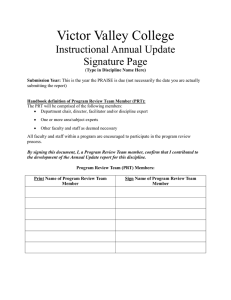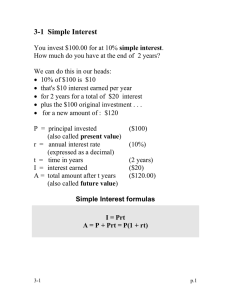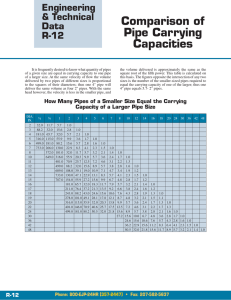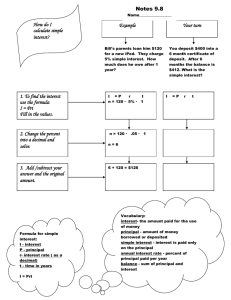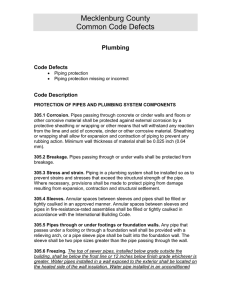Title of Innovation: Summary Description
advertisement
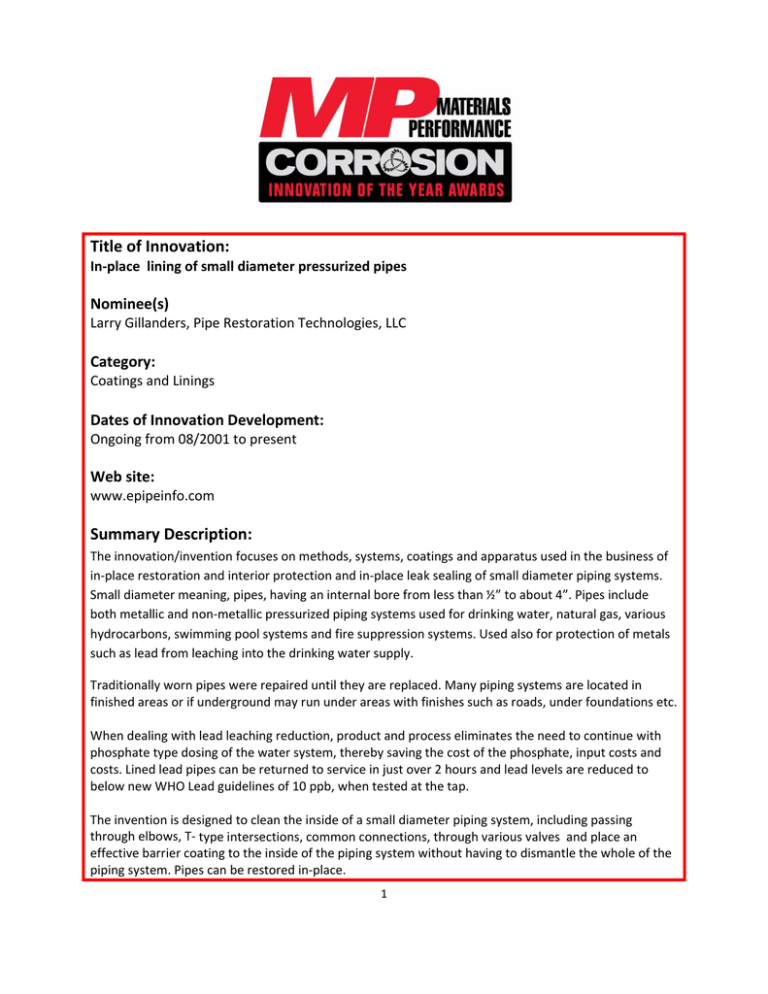
Title of Innovation: In‐place lining of small diameter pressurized pipes Nominee(s) Larry Gillanders, Pipe Restoration Technologies, LLC Category: Coatings and Linings Dates of Innovation Development: Ongoing from 08/2001 to present Web site: www.epipeinfo.com Summary Description: The innovation/invention focuses on methods, systems, coatings and apparatus used in the business of in‐place restoration and interior protection and in‐place leak sealing of small diameter piping systems. Small diameter meaning, pipes, having an internal bore from less than ½” to about 4”. Pipes include both metallic and non‐metallic pressurized piping systems used for drinking water, natural gas, various hydrocarbons, swimming pool systems and fire suppression systems. Used also for protection of metals such as lead from leaching into the drinking water supply. Traditionally worn pipes were repaired until they are replaced. Many piping systems are located in finished areas or if underground may run under areas with finishes such as roads, under foundations etc. When dealing with lead leaching reduction, product and process eliminates the need to continue with phosphate type dosing of the water system, thereby saving the cost of the phosphate, input costs and costs. Lined lead pipes can be returned to service in just over 2 hours and lead levels are reduced to below new WHO Lead guidelines of 10 ppb, when tested at the tap. The invention is designed to clean the inside of a small diameter piping system, including passing through elbows, T‐ type intersections, common connections, through various valves and place an effective barrier coating to the inside of the piping system without having to dismantle the whole of the piping system. Pipes can be restored in‐place. 1 For pipes that carry drinking water, the proprietary coating meets the health regulations for contact with drinking water system in the UK, EU, USA , Canada , Russia, and Mexico where restored pipes from less than ½” bore may be returned to service in as little as 2 hours. Making this the fastest in‐place restoration system for small diameter pipes carrying drinking water in these jurisdictions. 9 patents have been issued by the US Patent Office, 1 European patent and 1 Canadian Patent at the time of this submission with additional patents pending. 2 Full Description: How does the innovation work? When and how was the innovation developed? Since about August 2001 to the present lining techniques, equipment and materials have been developed and commercialized. The primary aspects of the innovation/invention lay in the methods developed to rehabilitate small diameter pressurized pipes in‐place. Essentially extending not only the life of the piping system but reducing/eliminating pinhole leaks ie: loss 3 of water or natural gas. In the case of lead pipes reduces lead leaching to below Dec 2013, WHO regulations. How or why is the innovation unique? Ability to restore pressurized pipes “in‐ place” in a single pass operation, sealing leaks and reducing lead leaching. The coating material can be cured in at least 1‐4 hours. Conforms to EU and US(NSF) requirements for immediate return to service when in contact with drinking water in pipes from as small as ½” ID. What type of corrosion problem does the innovation address? Reduces water to pipe wall contact and is effective in reducing the negative effects of the use of chloramines in contact with drinking water pipe walls. What is the need that sparked the development of the innovation? The concept was to rehabilitate small diameter pipes in place Are there technological challenges or limitations that the innovation overcomes? Major challenges involved economical cure and application times with the coating that had to conform to health regulations when contact with drinking water What are the potential applications of the innovation? see below How does the innovation provide an improvement over existing methods, techniques, and technologies? see comments below What type of impact does the innovation have on the industry/industries it serves? see comments below Does the innovation fill a technology gap? If so, please explain the technological need and how it was addressed prior to the development of the innovation. see comments below 4 Has the innovation been tested in the laboratory or in the field? If so, please describe any tests or field demonstrations and the results that support the capability and feasibility of the innovation. This process of approving the epoxy lining material and process of application falls under three primary categories: Health, Physical Properties and Code Compliance. The lining material referred to as a “coating” has to be approved, safe for use with drinking water, meet industry standards for adhesion, durability, meet taste and odor tests if end use is intended to come in contact with drinking water and be applied to meet existing plumbing codes. In Canada and the US, standards have now been adopted by both major plumbing codes, IAPMO® and ICC‐ES® relating to the process and coatings applied all of which are founded off the key invention described here . IAPMO® has provided for an Interim Guide Criteria for Internal Pipe Epoxy Barrier Coating Material for Application in Pressurized (Closed) Water Piping Systems. Originally adopted as IGC 2003, several updates have brought the Interim Guide Criteria to its current version, IGC 189‐ 2008, which covers applications of epoxy lining to both metallic and non metallic piping systems. This standard provides minimum standards for the manufacture and performance of epoxy barrier coatings, mechanically applied to the interior surfaces of piping systems and includes referenced standards: ANSI/NSF 61, Drinking Water System Components ‐ Health Effects, ASTM D 4541, Pull‐Off Strength of Coating Using Portable Adhesion Testers, AWWA C210, Liquid‐Epoxy Coating System for the Interior and Exterior of Steel Water Pipelines ICC‐ES® has adopted an Acceptance Criteria referred to as Internal Epoxy Coating Pipe Material Acceptance Criteria (AC 298), approved October 2005. This acceptance criteria was intended to establish the minimum criteria necessary for the use of a proprietary, mechanically mixed, blended, epoxy barrier coating that is mechanically applied to the interior of rigid pressurized water pipes. Codes and Referenced Standards include, 2003 International Plumbing Code®, 2003 International Residential Code®, International Code Council, ASTM D 4541‐02, Standard Test Method for Pull‐Off Strength of Coatings Using Portable Adhesion Testers, ASTM International, NSF 61‐2004, Drinking Water System Components ‐ Health Effects, National Sanitation Foundation and AWWA C210, Liquid‐Epoxy Coating System for the Interior and Exterior of Steel Water Pipelines. AC 298 expanded on IAPMO’s IGC 189 and addressed pipe cleaning standards, the effects of the lining material on flow rates, pressure loss and established evaluation report verification criteria. In 2007, the first Evaluation Service Report, based on AC 298, was completed on the, ePIPE® patented method of pipe restoration by ICC‐ES auditors, which resulted in the issuance of Evaluation Report ESR#1390. In UK as recent as September 2012, the Secretary of State under the Drinking Water Inspectorate’s Regulation 31 has approved the methods of small diameter pipe lining using the methods and lining materials described with this invention. First, in its field. 5 Is the innovation commercially available? If yes, how long has it been utilized? If not, what is the next step in making the innovation commercially available? Overview Pipe Restoration Technologies, LLC (“PRT”), organized in 1998, owns and develops the proprietary and patented intellectual property rights to a small diameter pipe restoration process and system. The initial launch began in Vancouver Canada and within a few years PRT made its initial expansion south of the border first to Seattle and then into Southern California and into the Washington DC area. Our Group PRT is the licensor of ACE DuraFlo Systems, LLC and owner of US based Pipe Restoration Inc. PRT has also expanded internationally with Joint‐ Venture interests in Pipe Restoration Technologies, Espana and Pipe Restoration Services. UK ACE DuraFlo Systems, LLC is the licensee of our intellectual property in North America to third party applicators. Pipe Restoration, Inc. provides direct residential and commercial customer application of the ePIPE® process, provides research and development activities, including infield testing to PRT and provides initial technical training and support training for our North American and International licensee network. 6 The ePIPE Technology PRT’s core intellectual property includes our process and system, epoxies, methodology of operations, specialized equipment, extensive patent portfolio, trademarks and technical expertise in the business of small diameter pipe restoration (see www.epipeinfo.com) The ePIPE® Process and System Internationally In 2010, PRT formed a UK joint venture corporation, Pipe Restoration Services Limited, with its 50% partner, Morrison Utility Services (MUS), one of the UK’ s leading utility services providers (2010 annual sales est. £1.5B). (See websites: www.morrisonus.com and www.piperestorationservices.co.uk) PRT is working with MUS to develop a long term remediation solution for the estimated 10 million lead service lines within the UK and the Republic of Ireland currently facing new and significantly more stringent European Union potable water testing standards for lead that come into effect in 2013. An initial estimate is that 25% of domestic dwellings in the EU have a lead pipe, either as a connection to the water main, or as part of the internal plumbing, or both, potentially putting up to approximately 120 million people or more at risk from lead in drinking water within the EU. PRT has received both UK Water Regulations Advisory Scheme (“WRAS”) approval for the private side of the service lines and approvals from the UK Secretary of State for the public water supply systems. And is the first and at this time the only company focused on small diameter pipe restoration to be so approved. PRT also has licensed its ePIPE® technology internationally: 7 Spain – initial geographic licensee began operations in 2006 and deployed its first set of equipment in 2007. Currently, a national Master Licensee and several geographic regional sub‐ licensees. PRT maintains an equity stake in the Spanish entity. Belgium – licensee covering East and West Vlaanderen and surrounding region which began operations in 2009. Finland – licensee began operations in 2010. Moscow, Russia – regional licensee signed in 2012. Mexico – regional license in the Monterray began operations in 2009 Patented and Proprietary Technology The ACE DuraFlo® proprietary and patented technology, known under the ePIPE® brand, is a technical process for “in‐place” cleaning and reconditioning of pipes of various compositions having diameters of up to 4” (small diameter). The primary process involves a drying process, followed by cleaning the pipes with an abrasive material; blowing the pipes clear with compressed air and lining the pipes with proprietary epoxies through the application of pressure controlled air, moisture and heat. This technology allows the building owner to have its pipe systems restored “in place” instead of being repaired “in place” or removed and replaced. This process minimizes the disruption to the building owner and may be more cost effective than repairing or replacing worn out, damaged, or corroded pipes and may avoid most of the demolition and repair to the building associated with replacing pipes. The market for PRT’s method of pipe restoration services includes any building or facility with pipe systems having pipe diameters of 3/8 inch to 4 inches of various metal and non‐metallic composition, lengths, and configurations. Houses and other buildings that were built more than 20 years ago with galvanized steel or lead piping, newer structures that were built with copper piping in areas that present environmental challenges, aggressive water or particular water treatment challenges, or pipes with faulty installation, are particular targets for the ACE DuraFlo® process. In addition to thousands of homeowners, our commercial clients include: US Government, top tier hotel brands, such as Four Seasons, Sheraton, Marriott, Accor and Fairmont, the Aerospace industry, such as Boeing, and insurance providers. PRT has expanded its methods of application and types of coatings to be in a position to exploit the opportunity in the EU brought about by EU legislation to reduce dissolved lead from entering the drinking water from lead service lines. It is estimated that in the UK there are an estimated 10 million lead service lines a similar number exist for France. In the US it is 8 estimated that some 38 million homes are affected by lead contaminated pipes. The coating product and processes developed in concert with the UK lead remediation program provide for an approved drinking water contact material, in pipes having an internal bore as small as 12mm (3/8”), with a 2 hour return to service. This places PRT as having the one of the fastest return to service epoxy lining systems in the world for contact with drinking water in pipes having an internal bore in the range of 12mm to 50mm (about 3/8” to 2” ID) Composition, process and methods patents have been granted in the USA and in process internationally specific to this 2 hour return to service product and process. Approval of Products in Contact with Potable Water Owing to the highly specialized nature of our business associated with small diameter pipe restoration, PRT’s epoxy lining product for potable water is one of only a handful of products that are listed with the National Sanitation Foundation (NSF) meeting the Immediate Return to Service criteria for both commercial hot and cold water applications on pipe sizes of ½” or greater. PRT’s potable water epoxy lining is approved and meets health guidelines in the US, Canada, Mexico, Latin America, Singapore, Romania, Spain, Belgium, Finland, Russia and in the UK. In the UK, approval has been received from both WRAS (Water Regulatory Advisory Scheme) for the private side of service lines including buildings and for the utility side use from DWI. (Drinking Water Inspectorate‐Secretary of State, UK) Product Approval ‐ United States Market Place In the United States, plumbing products, especially those designed to be in contact with potable water require multiple levels of approval before being allowed to be installed. Model Codes ‐ in the US there are 2 primary plumbing codes: 1) the UPC® ‐ Uniform Plumbing Code, and 2) the IPC® ‐ International Plumbing Code. To generalize, the areas of the United States that have adopted these model codes are basically split east and west along the Mississippi River. Most regions in the east have adopted the IPC® and the west has adopted the UPC®. PRT obtained a UPC® listing in 2002 and in October 2007 obtained IPC® approval. To date, in the US and Canada we are the only listed lining material product approved for both metallic and non‐metallic piping systems. In addition there may be additional city or county requirements which need to be met before approval to install a product within their territories. These approvals generally rely on the two primary model codes and other approvals a product may have been previously granted. Such additional approvals are identified prior to applying for permits for a specific customer project. 9 Product, Market Development and IP PRT started in 1996 with initial market investigation and by 1998 PRT’s founders completed the first phase testing of the prototype commercial program. Prototype equipment and coatings were deployed in 1999. Initial patent filings were made in 2002. Presently PRT has 9 issued US Patents, 2 Internatiional Patents and numerous patens pending. Trademarks and Copyrights Specifically in the USA, Canada, Australia, New Zealand, and the EU, PRT has trademarked its primary marks, ePIPE®, and ACE DuraFlo® and has international copyright protection on other key images. A host of other strategic marks in commerce are also trademarked in the US and Canada. Expanded Product Offering PRT has expanded its product line to include: potable water, commercial application, residential application, miniE® single line restoration, heating and cooling systems, fire suppression systems, natural gas systems and lead pipe remediation. In the fall of 2012 PRT, though its UK subsidiary, entered into a research and development program with a collaboration of UK natural gas supply companies. Focus of this 18 month R&D program is the development, using ePIPE technology, to restore “in‐place” gas riser systems in the UK. Licensing – North America Overview PRT enters into licensing agreements with its North American licensees to identify their businesses under the ACE DuraFlo®, miniE®, or ePIPE® trademarks and use the technology to clean and recondition pipes of various types and sizes using three different application configurations depending on their licensing and equipment packages: miniE® single line remediation, ePIPE® residential, and ePIPE® commercial. In North America, PRT licenses its technology through ACE DuraFlo Systems, LLC. The licensing models developed by PRT/ACE are: 1) franchising and 2) technology licensing agreement. Traditional Franchising ACE DuraFlo Systems, LLC is a registered franchisor in the USA and annually files a Franchise Disclosure Document with the Federal Trade Commission to enable it to sell franchises in the 10 US. Under the traditional franchise model we license, train, provide equipment and consumables, plus provide ongoing business and market support to our franchisee network. The franchisee licenses for a defined market territory and in return pays ACE an upfront fee, purchases equipment and consumables, pays an ongoing sales royalty and contributes to a national advertising fund. Technology licensing program In 2006, ACE began to provide licensees access to the miniE® or the ePIPE® technology and marks only. No ongoing business and marketing support is provided. The technology licensee licenses a defined market territory and in return pays ACE an upfront fee and purchases equipment and consumables. Technology licensing is the model used exclusively with our affiliate and affinity licensees, Mr. Rooter, RotoRooter, Ben Franklin, American Leak Detection, and BuyMax. The technology licensee is a member of an existing franchisee network or member of an affinity program. These licensees effectively are dual branding their service offerings with the addition of the miniE® or ePIPE® product lines. Are you aware of other organizations that have introduced similar innovations? If so, how is this innovation different? Are there any patents related to this work? If yes, please provide the patent title, number, and inventor. *LARRY GILLANDERS IS NAMED INVENTOR FOR ALL PATENTS* US Patents: #7160574 – Barrier Coating Corrosion Control Methods and Systems for Interior Piping Systems #7517409 ‐ Barrier Coating Corrosion Control Methods and Systems for Interior Piping Systems #7858149 – Methods and Systems for Coating and Sealing Inside Piping Systems #8033242 ‐ Methods and Systems for Coating and Sealing Inside Piping Systems #8206783 ‐ Barrier Coating Corrosion Control Methods and Systems for Interior Piping Systems #8343579 ‐ Methods and Systems for Coating and Sealing Inside Piping Systems #8354140 ‐ Barrier Coating Corrosion Control Methods and Systems for Interior Piping Systems #8399813 – Portable Heating Apparatus for Heating Interior Piping Systems #8524320 – Process for Coating the Interior Surface of Water Service Lines 11 Canadian Patent #2707023 – Methods and Systems for Abrasive Cleaning and Barrier Coating/Sealing of Pipes European Patent #2099581 ‐ Methods and Systems for Coating and Sealing Inside Piping Systems 12
